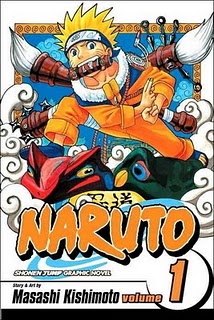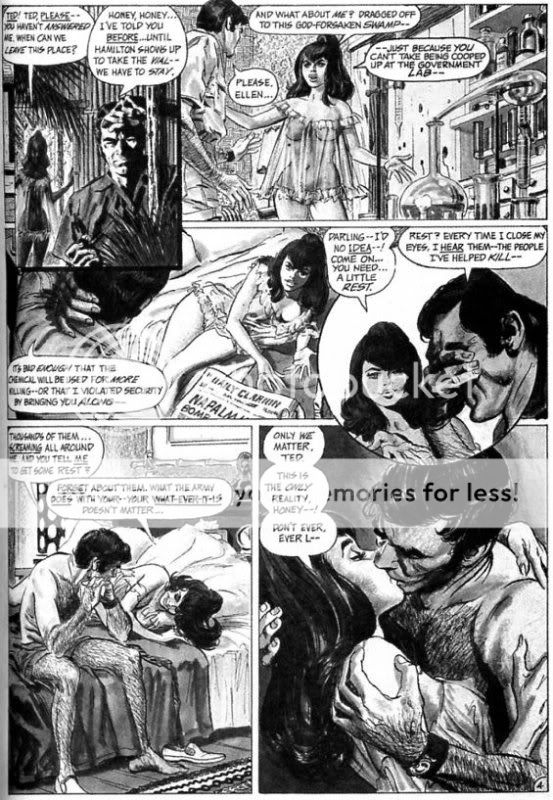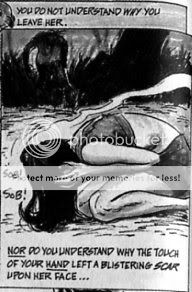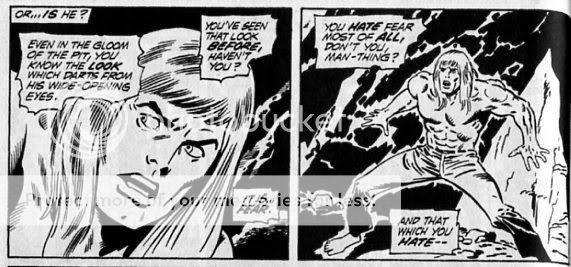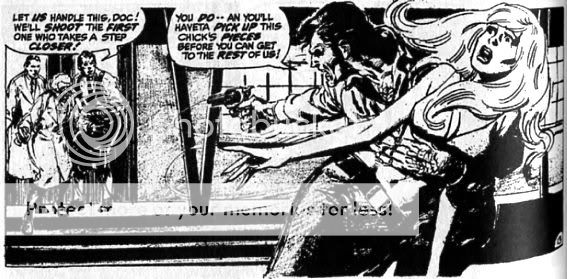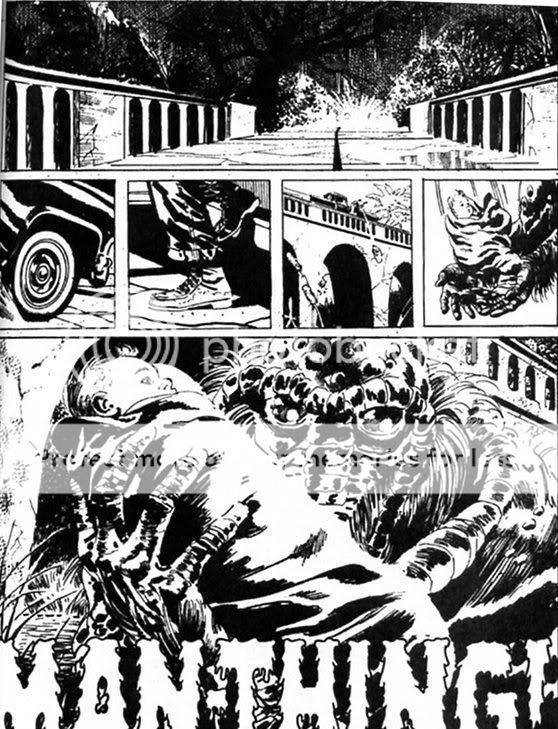We’re following up on some Tucker Stone on Man-Thing action. At the conclusion of his review Tucker laments that he didn’t get to review Fear #15 because it looked like Man-Thing fought fighter jets and that seemed like it might be cool. He doesn’t and it isn’t.
Fear #15
Writer: Steve Gerber
Penciler: Val Mayerik
Inker Chic Stone
At the end of my last post I wondered aloud how exactly Steve Gerber was going to save us from creeping genre confusion. Was he going to just embrace the obvious and make Man-Thing the horror title it clearly wanted to be? Or would he manage to mix horror and super-heroics or melodrama or whatever in some way that wasn’t obviously stupid?
And the answer is…neither. Gerber just chucks the horror tropes altogether. And it’s still stupid.
I guess I’m supposed to be appreciating the Silver Age goofiness, and it’s certainly true that the narrative veers all over the place. Continuing over from last issue, we start with everyone in the world going insane. Then we’ve got Man-Thing being shot by rural yahoos, then on to magic ritual, a flashback to an Atlantean sorceress, the sudden appearance of a wizard complete with goofy wizard hat so you can spot him, unlikely mystical quest, monster fight monster, good monster win, victory, the end.
So as I said, pretty crazed. And yet, Gerber manages to take this zany, cobbled-together plot and make it really tedious. It’s true that the story is a heterogeneous mish-mash. But when, say, Bob Haney put together a heterogeneous mish-mash he did it with verve and panache; you felt like he was bouncing form idea to idea because he’d thought of something so funny and delightful he just had to drop it in. Ghost peg-leg pirates; Batman turning into a mad scientist, Spanish kids calling the Dark-knight detective Bat-Hombre; rallies for robot rights — the man was having a blast. (And it didn’t hurt that he worked with a number of brilliant artists like Nick Cardy and Jim Aparo. Mayerik’s okay, but he’s certainly not in that class.)
Whereas with this Gerber story, it’s more like a Hollywood movie assembled by committee that never managed to gel — Superman IV, for example, or Judge Dredd. The individual bits aren’t exciting or clever; they’re boring. The Atlantean sorceress, for example, is just Jor-El in a two-piece, warning everyone that the world’s going to end. The wizard who suddenly appears has no discernible personality — he just has “to make certain you were the ones!” Yep, that’s a news flash. The main character, Jennifer, is as bland as her good looks ; now she’s spouting courageous drivel, now she’s weeping because Man-Thing is dead — who gives a shit? Even the prurient touches are lame:
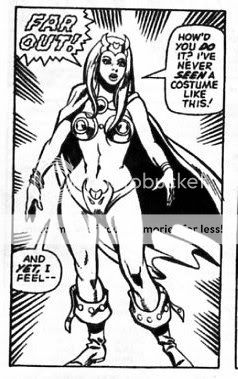
Nice crotchface there, Jen. Good to know you’re comfortable with that.
In short, this feels like hack-work…except for a couple of moments. The first is on the second page; Gerber explains, straight-faced, that one sign of the demonic possession of the earth is that “rock-hurling protestors demand that the President resume the war!” The second is further on; Jennifer and Man-Thing find the sacred tome (isn’t there always a sacred tome?) when suddenly:
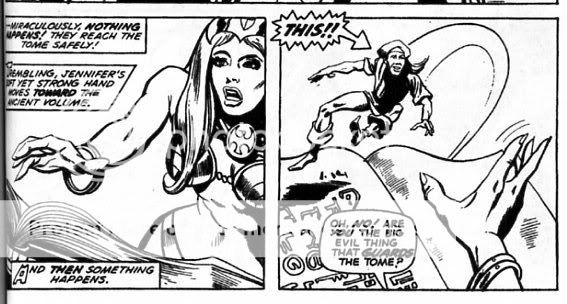

And that’s it; the elf disappears, big evil monster appears, and we’re back to formulaic drudgery. Blink and you’d miss it, but for two or three panels there we’re in Flaming Carrot or Cerebus territory. There’s at least a little more of that coming, thank God. First though, we’ve got to endure….
Fear #16
Writer: Steve Gerber
Penciler: Sal Trapani
Inker Chic Stone
From Hollywood schlock to a Very Special Issue of Man-Thing. The bad men are trying to pave paradise and put up a parking lot. The noble Indians fight back, Man-Thing stands around and drips. Everything drips, for that matter. Soggy ideologies slosh back and forth like stubborn, intolerant hamburgers wrestling with proud, game corn tortillas for possession of your lower intestine, which is sacred to both. But do not be afraid, for if you are, the arrugala with the big nose will shoulder all aside and burn a hole in your pasty white sphincter. Or, as Michael Kupperman famously put it, “The tribes of my people used to cover the land, as numberless as the buffalo. Now we are dead and inside your sticks of chewing gum.”
Fear #17
Writer: Steve Gerber
Penciler: Val Mayerik
Inker Sal Trapani
The title here is “It Came Out of the Sky!”, and it opens with three and a hlaf pages of Man-Thing in single combat with the spacecraft from Action Comics #1. We learn where Man-Thing’s ears are (in his forehead) before he finally cracks the thing open revealing…the second backstory flashback in three issues that retells the damn Jor-El narrative. This time it’s not a semi-nude Atlantean witch, but a dude named Hektu who does the useless warning schtick. The sun! The sun! It will explode! Ha, ha, he’s crazy. I know…let’s build a rocket..yadayadayada. It’s a straight, retelling…until:
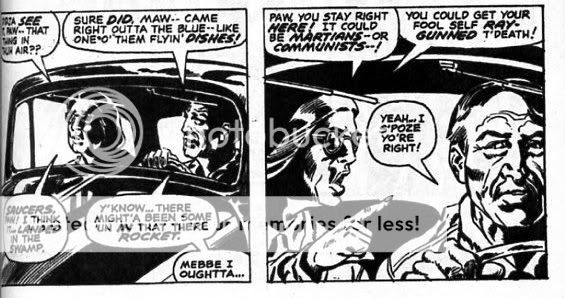
Yep, the Kents are portrayed as small-minded rural hicks. It’s a stereotype, sure, and an obvious thing to do in a way…but it’s also bracingly mean-spirited and, most of all, completely out of nowhere. There’s nothing in the Jor-El retelling to indicate that it’s a satire and not a dopey retread. Indeed, it is a dopey retread, complete with melodramatic voice over (“It is the weight of a lifeless hand…that pulls the lever down…and sends the ship skyward!”) It’s like Gerber was telling a standard issue, derivative comic retread, and then all of a sudden said, “You know what? Fuck this.” And hey, presto, we’ve got anti-Kents and then, next page, we’re introduced to Wundarr! a Superman who grew up alone in the spacecraft, pops out of it, sees Man-Thing, and thinks the shambling monstrosity is his mother.
That’s the joke; a developmentally-challenged Superman. And you know what? It’s pretty funny. Wundarr can’t control his muscles so he bounces around spastically, leaping about the swamp, smashing up the construction equipment of the evil developers (yes, they’re still around), staring vacantly into space, tipping over into the muck face first, accidentally killing an alligator, and finally trying to cuddle with ol’ mother Man-Thing. This last precipitates the big super-power battle in the center of town…until Man-Thing gets tired and wanders off. Wundarr is sad…and then scared that his Mom is abandoning him. Of course, Man-Thing can’t tolerate fear, and so he slaps the man-kid, leaving a slight burn on Wundarr’s cheek, and then lumbering off.
Along the way you’ve got lots and lots and lots of hyperactive voice-over. Neither Man-Thing nor Wundarr can actually talk, and though Mayerik has a grand old time drawing Wundarr’s goofily clueless expression:
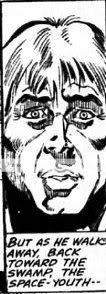
we can’t really expect Marvel readers to read facial subtleties. So we’ve got captions like:
“But the Ma-Thing has mistaken Wundarr’s accident for an attack — and so stalks menacingly toward him — to retaliate! Can this be? Will even his ‘Mother” be mean to him? Yes! Yes! “She” is going to hurt him!”
You’ve got to love that “‘she'” in quotes especially. Cause, without the quotes, you might start to think that Man-Thing is actually a “she” right?
In a way, it’s kind of entertaining; what happens to a Marvel writer if he can’t explicate everything endlessly through speech bubbles? He goes insane! But at the same time… this is a nifty story with some clever ideas and a loopy sense of humor…wouldn’t it be great if it were being told by someone who could write? Someone who, say, could have figured out a way to do something interesting with the Jor-El retelling, so you’re not just bored and irritated for three pages; somebody who didn’t have to underline every potentially poignant moment with three or four exclamation points.
It’s like, you’ve got an Alan Moore story with Stan Lee storytelling; there’s a funny, original, and even subtle tale here, but the voice and the pacing are just for crap. It reminds me of the last time I went to see the Flatlanders actually. For those who don’t know, the Flatlanders were an early 80s hippie country band; great spaced out playing, lovely melodies. Anyway, they got back together because they could make a buck, presumably, and their new material is dreadful, but of course they played a lot of old stuff as well, which was enjoyable…except they had hired The Worst Drummer in the World to perform with them, and there they are singing their pretty, ragged, spacey melodies, and over everything is this guy basically hitting his kit with his forehead: Thump! (pause) Thump! (pause) Thump! Each beat sits there as if to say, yep, I’m a big stinking turd, and the next one’s coming predictably right — Thump! Yep, there it was.
Okay, you got me. I’m just stalling. I don’t want to go on to:
Fear #18
Writer: Steve Gerber
Penciler: Val Mayerik
Inker Sal Trapani
It’s another Very Special Issue of Man-Thing. This time there’s a bus accident, and the bus is filled with rejects form last night’s lousy late night movie. There’s the nurse with the heart of gold! The wounded child! The tough and manly All-American Nam vet! The disillusioned student protestor with the heart of gold! The drunk-driving salesman who caused the whole thing, the bastard!
And is there conflict? Oh yes, there is conflict. But Man-Thing follows them around like a good puppy and protects them until the bad salesman kills everybody except the nurse and the kid and then Man-Thing kills the bad salesman because that’s what good monsters do. And it’s all so heartwarming that it brought a tear to my eye…oh, wait, I just have conjunctivitis. Never mind.
Perhaps I’m missing something obvious, but…who wants to read this? You pick up a Man-Thing title with some giant gloppy, dripping monster on the cover, you’re saying to yourself…y’know, I’d really like to see a sixth-rate stage play about the human passions boiling just below the surface in my fellow sufferer, with a heartwarming finale about the way love and tenderness can bridge the gap between man and thing? Or are you maybe saying instead, I want to see some havoc, I want to see mayhem, I want to see people brutally killed, I want to see guts and brains and dismemberment and mean-spirited nihilism?
I’m willing to work with Gerber to some extent. Okay, he’s not into carnage. I’ll settle for goofiness. I’ll settle for a decent story. But this…this is just egregious crap. This is a hack writer who isn’t even a decent hack; a preening twit spouting empty-headed platitudes: “Mary, Look around you! It’s not just me! It’s our whole blasted country! We all hate life!” Yes, I hate life, and the reason I hate life is that I’m reading your pompous, boring-ass shit.
All these irritating, incredibly trite characters? Man-Thing. should. kill. them. That’s what horror is for, damn it. The whiny hippie who says he hates life should piss himself and beg and beg and beg for mercy as Man-Thing rips his still-beating pansy heart from his rib-cage. The manly Nam vet should have a poignant scene where he talks about being tortured by Charley and how glad he was to escape, and then, in the next panel, he should get his leg torn off and bleed hideously to death. The nurse should reach out to Man-Thing and ask him to please save this innocent child’s life, and then Man-Thing should smother the kid to death as she watches and then snap her sanctimonious neck. And the evil, uber-patriotic drunk driver, who killed all those people? Well, Man-Thing should…um…
Aw, fuck it. The drunk driver can escape. He’s a lot less annoying than the others anyway.
_________
Tucker’s back tomorrow with more, as we all wonder why this is a cult classic, anyway.
Update: And Tucker’s next post is up.



